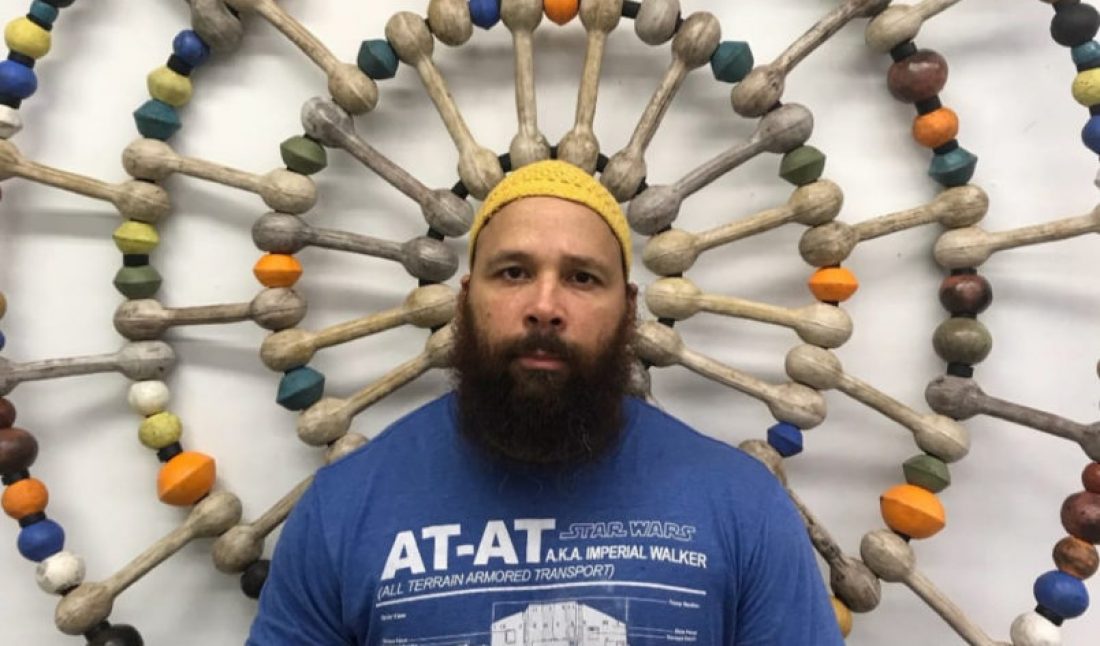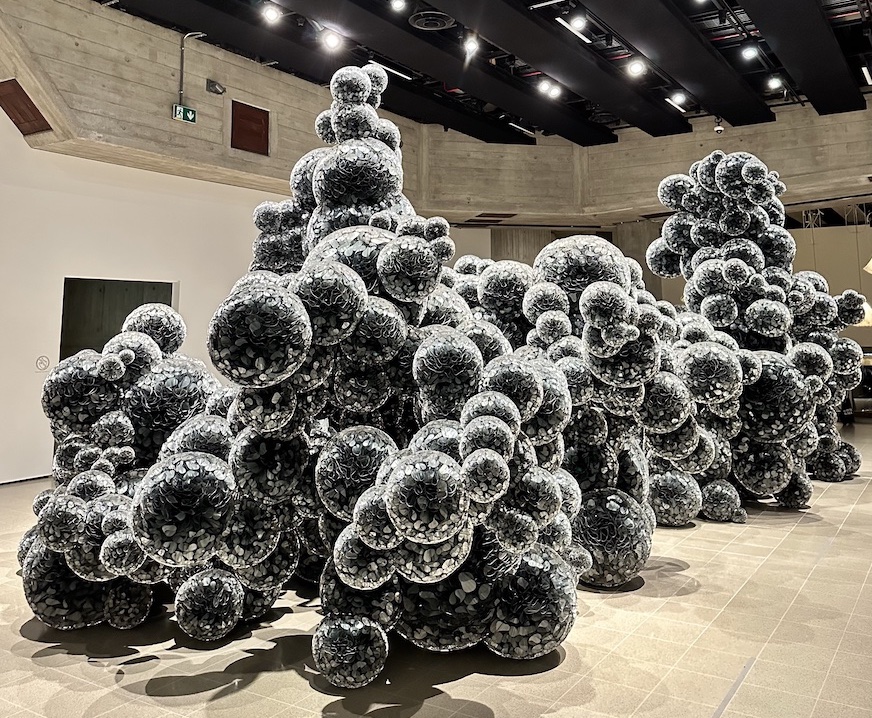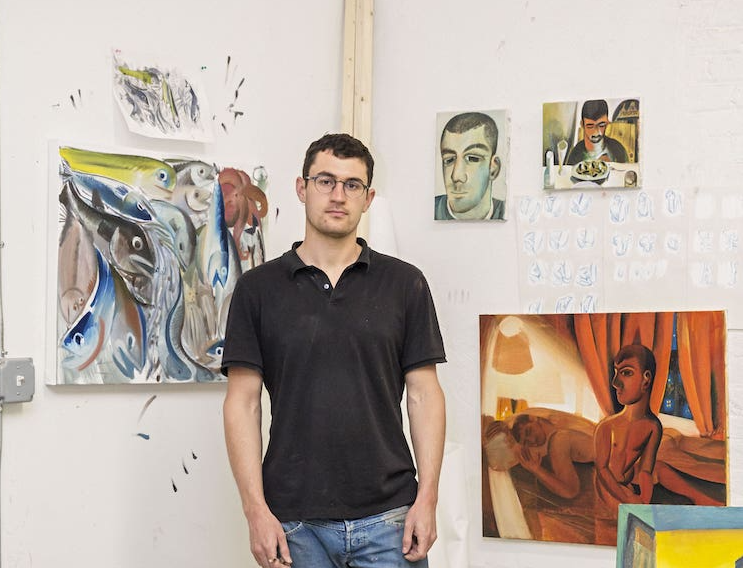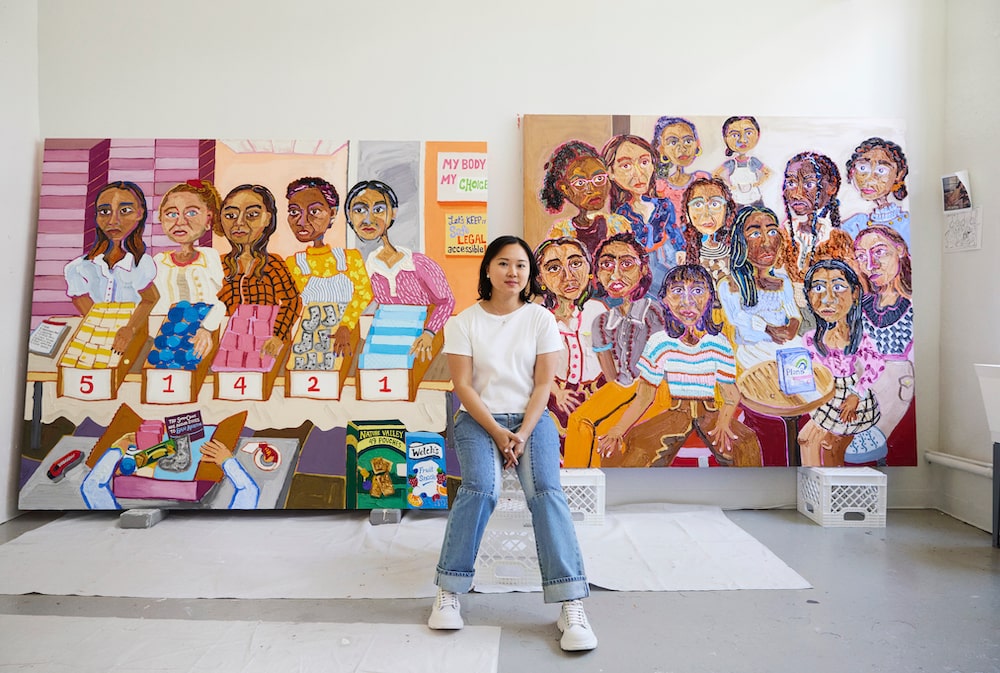When gazing upon the work of Sharif Bey, a juxtaposition of elements like historical and contemporary or functional and sculptural begin to catch the eye. Entire necklaces are made from tiny pinch pot-style vessels as beads, large mask-like works reference art from Western Africa—like the Kongo peoples’ nkisi nkondi and Benin sculpture—and imagery like a raised fist looks to modern-day power symbolism.
In Bey’s current exhibition at Albertz Benda in New York City, “Revelations in Power,” these qualities continue as the artist looks at manifestations of power through a lens that acknowledges stereotypes as an opportunity for discovery. Open through March 27, the show takes works from several of the artist’s series, (including “Protest Shields,” “Power Figures,” “Necklaces,” and “Boilermaker.”), inviting the viewer to follow Bey’s artistic journey through pieces like the face haloed by a protrusion of fists titled Protest Shield: Zulu Nots and the compelling Nazarite, which has nails protruding from much of its surface.
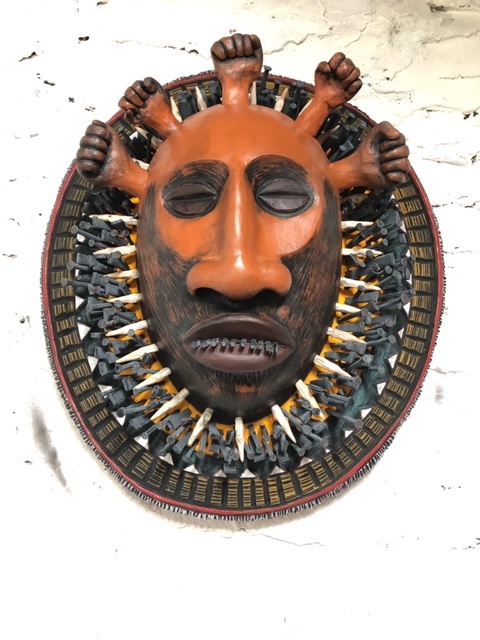 Sharif Bey, “Protest Shield: Zulu Nots,” 2021,
Earthenware and mixed media, 22 x 20 x 8 inches; courtesy of the artist and Albertz Benda.
Sharif Bey, “Protest Shield: Zulu Nots,” 2021,
Earthenware and mixed media, 22 x 20 x 8 inches; courtesy of the artist and Albertz Benda.
WHITEWALL: In “Revelations in Power,” you explore how power is manifested. How did you arrive at that theme?
SHARIF BEY: My earliest vessel-inspired forms evidenced an obsessive investment in pattern. I spent hours scarring clay surfaces with textures and linear patterns, hoping to transcend mundane functional pots. In graduate school, 20-years ago, I modeled figurative objects, intending to take advantage of the responsive and visceral nature of clay in order to capture compelling facial expressions and body language. Years later I created objects of great scale, made in proximity to the body, referencing adornment and sculpture and shifting from the intimate to the monumental. While these may appear to be completely different creative pursuits, when I look back, I see a common denominator in all these endeavors: Explorations of Power.
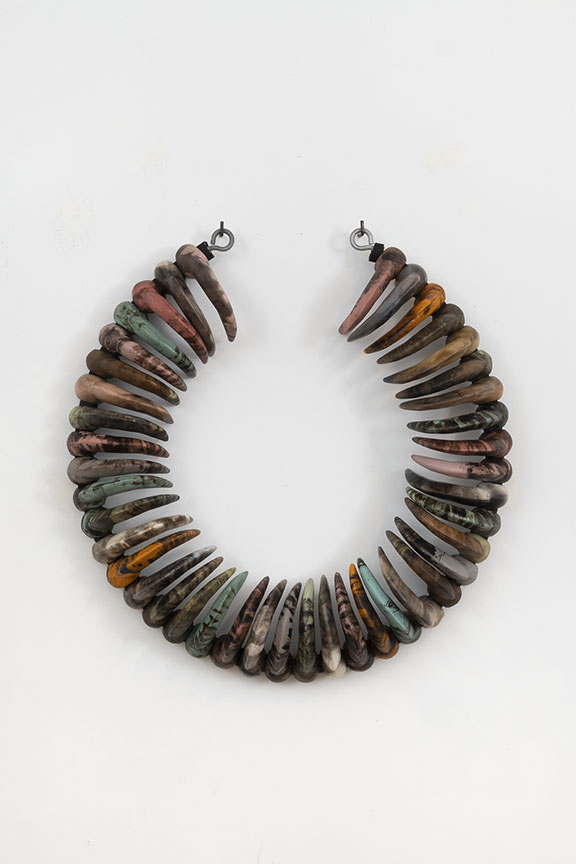 Sharif Bey, “Raptor Quilt,” 2021, Earthenware and mixed media, 25 x 24 x 3 1/2 inches; courtesy of the artist and Albertz Benda.
Sharif Bey, “Raptor Quilt,” 2021, Earthenware and mixed media, 25 x 24 x 3 1/2 inches; courtesy of the artist and Albertz Benda.
WW: Can you tell us about the four series included in the show, “Protest Shields,” “Power Figures,” “Necklaces,” and “Boilermaker”?
SB: The “Power Figures,” impaled with countless nails, staples, eye screws, and bolts, started out as merely decorative. They are certainly figurative but like many of my works, they pay homage to the vessel.
In my “Boilermaker” series I create nkisi nkondi-inspired bottles around the size of a pint. Nkisi power figures, originally from the Congo region in West Africa, were used to affirm oaths and ward off evil. In addition to referencing this history, I also reference my own lived history as the son of a retired Boilermaker. Boilermaker is also a dual reference as it is a beer cocktail, originating from the experience of the weary industrial worker who needs to take the edge off and a pint alone isn’t enough, so he opts for a shot of whisky while he waits for the tap to settle.
The “Protest Shield” series emerged serendipitously. I worked in my small home studio during quarantine, endeavoring to make vessel forms about as large as I could fit through the doorway. The vessels each featured a large, centralized face framed with ornate decorative carving with bold colors. I also made these works in the context of the protests and unrest that took place in 2020. These objects are designed to empower and protect (as would a shield).
In [“Necklaces”] I explore the bead as a symbol for cultural and political identity. The design and form of clay beads are notable ways of distinguishing African societies of various cultural, religious, and geographical backgrounds. The symbolic meaning of beads in early African-American culture is speculative however some archeologists believe that beads were also connected to early slave barter systems. In this series, I juxtapose objects, symbols, and forms with hopes that the viewer will reconsider the relationship between body/adornment and personal or collective notions of power and value.
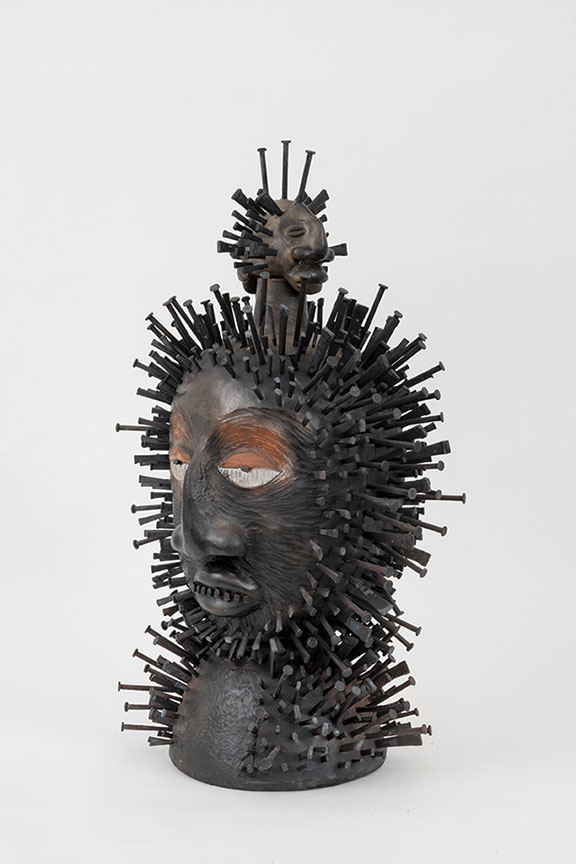 Sharif Bey, “Nazarite,” 2020, Earthenware and mixed media, 25 x 15 x 11 inches; courtesy of the artist and Albertz Benda.
Sharif Bey, “Nazarite,” 2020, Earthenware and mixed media, 25 x 15 x 11 inches; courtesy of the artist and Albertz Benda.
WW: The “Necklaces” series came to be after a shift in your practice, which happened once you started a family. Can you tell us about that shift?
SB: I used to have one mode of production in the studio. As a single person you can have it your way, so I took advantage of the freedom to stay in the studio and work. However, I didn’t discover the benefit of “coming up for air.” Art and rigor certainly informs art but so does life and leisure.
Obviously, life became instantaneously complex when I started a family. It is impossible to be insular when one has to invest in all of the ensuing communities that emerge to support families. I had to accept the integration of creativity and everyday life as opposed to viewing artmaking as an isolated experience.
When I began making the necklace-inspired works I was in the thick of my doctoral work, teaching on the side, and we had a toddler and a newborn. I had little time or focus to throw pots so I changed my way of working and began pinching clay forms by hand into small containers (which became beads)—something I could do in my living room while the kids played.
WW: Your work often embraces stereotypes and gives new context to preexisting motifs and art—particularly that from the West African oeuvre. Can you tell us about this?
SB: I am an avid collector of West African sculpture. I am particularly interested in how these kinds of objects evolve through time and how their meaning and signification change depending on the context. The Atlantic slave trade and the colonization of Asia and Africa have made a lasting impact on how non-Western cultural legacies are negotiated in the West. Whether we discover them in the British Museum, in Picasso’s studio, in a flea market, or in someone’s living room their reception is shaped by fetish, colonization, racism, and commercialism.
Stereotypes can impede our ability to extend and connect to potentially exciting revelations. Sometimes I reference imagery stemming from the physiognomy of Dan masks from the Ivory coast and people receive it as a minstrel show caricature. I am fascinated by when and where these references begin depending on who is viewing them. On what side of the ocean does this visual culture begin? I sometimes discover value and creative fonder in the cloudiness of it all.
One of my professors in grad school once advised: “Sharif, you might want to watch out for stereotypes.” After our discussion he redirected his gaze and stated, “Maybe I need to watch out for stereotypes.”
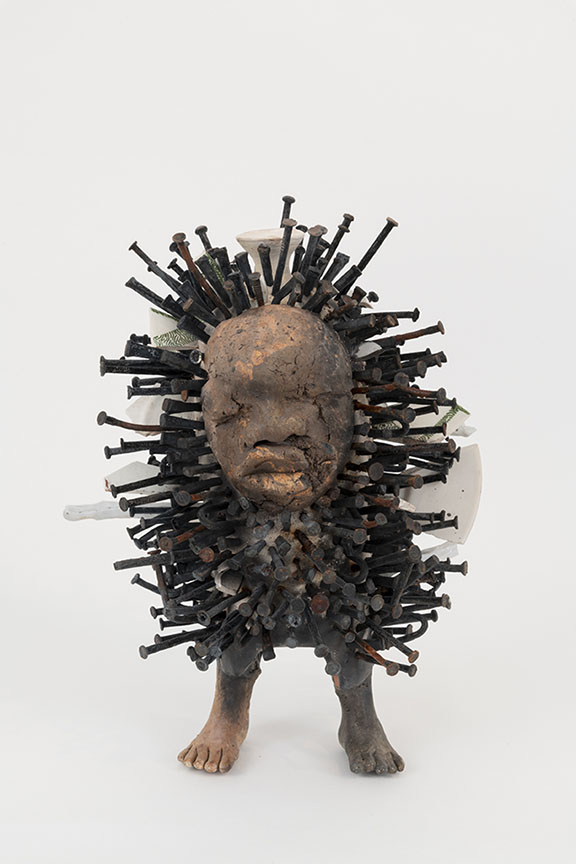 Sharif Bey, “Boilermaker: Fidel,” 2021, Earthenware and mixed media, 15 x 10 x 9 inches; courtesy of the artist and Albertz Benda.
Sharif Bey, “Boilermaker: Fidel,” 2021, Earthenware and mixed media, 15 x 10 x 9 inches; courtesy of the artist and Albertz Benda.






